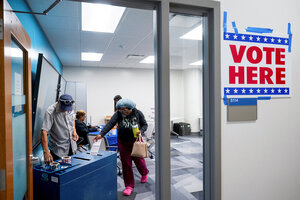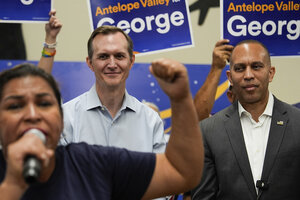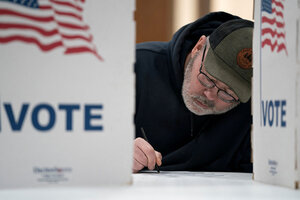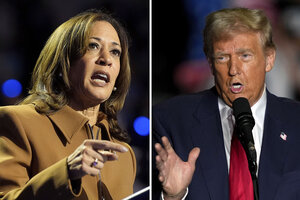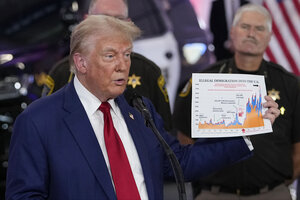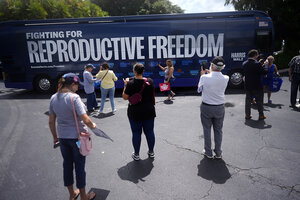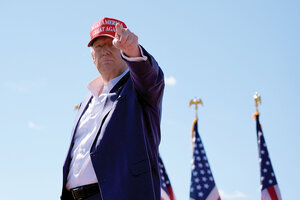On the plane with Harris – but is she really opening up to the press?
Loading...
| Aboard Air Force Two
The last time I flew Air Force Two, it was October 2006 and Dick Cheney was vice president. I was part of the small press corps covering the VP’s trip to Kansas and Louisiana.
So when the Monitor’s turn to fly with Vice President Kamala Harris came up late last week – for a campaign swing in Wisconsin and Michigan – I was struck by a coincidence: Vice President Harris, the Democratic nominee for president, would appear at a rally with Liz Cheney, the former No. 3 Republican in the House and daughter of the former vice president.
“Our republic faces a threat unlike any we have faced before,” Ms. Cheney somberly told the crowd in Ripon, Wisconsin, birthplace of the Republican Party in 1854.
A big blue “Country Over Party” sign hung over the scene. Legendary photographer Annie Leibovitz was there taking pictures for Vogue, focused on Ms. Harris.
It was the two politicians' first joint appearance since the conservative former Representative Cheney (and, just as noteworthily, her father) had endorsed the liberal Ms. Harris – an extraordinary break with the Republican Party and signal of the Cheneys’ passionate opposition to its nominee, former President Donald Trump.
Since Ms. Harris’ sudden rise to the top of the Democratic ticket in July, she has been criticized for being too cautious, doing few media interviews or town halls with voters. That’s changing – sort of.
On Sunday, a Harris interview with the popular podcast “Call Her Daddy” was released, aimed at women and younger voters. On Monday, Ms. Harris will appear on a “60 Minutes” prime-time special. On Tuesday, she’ll be on ABC’s “The View,” talk live with Howard Stern on Sirius XM Radio, and go on CBS’s “The Late Show” with Stephen Colbert. On Thursday, there’s a Univision town hall in Las Vegas.
It’s a lot of media, albeit with carefully chosen audiences. Aside from “60 Minutes,” the appearances are all on relatively friendly terrain – and perhaps reflect a shift in the power and reach of legacy outlets, which both candidates have largely ignored this cycle.
The small traveling press corps, which wants as much face time with Ms. Harris as possible, got five minutes of off-the-record Q&A at the start of the trip.
In her appearance at Ripon College in Wisconsin last Thursday, Ms. Harris spoke deliberately in her plea against Mr. Trump, like the prosecutor she used to be, making a closing argument before a jury.
The next day, in suburban Detroit, she appeared before first responders at the Redford Township Fire Station (no mention that the International Association of Fire Fighters just declined to endorse anyone this cycle) before heading to a packed rally in Flint, Michigan, where retired NBA superstar Magic Johnson, a Michigan native, lit up the crowd before Ms. Harris took the stage.
Ms. Harris also met privately with local Muslim and Arab American leaders – a critical constituency in the state – and heard their concerns about the Israel-Gaza war, according to her campaign.
Is she swaying any undecided voters in these final weeks? It’s hard to know. In Ripon, Wisconsin, she was addressing mostly a college crowd – a key demographic for Democrats. Some young voters said they cared passionately about this election; others said they’d come because classes were canceled and it was “something to do.”
Some older supporters also showed up. Retired college counselor Flora Stapel says she will “do anything to help Kamala.”
Frank Rubino, a retired family doctor, and his wife, Kathy, drove 125 miles from central Wisconsin.
“I tended to vote Republican until Trump,” Dr. Rubino says. “Now I’m a straight Democratic ticket. Democracy is absolutely important.”









